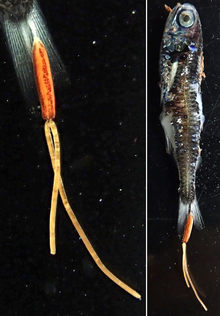| Peniculus hokutoae | |
|---|---|
 | |
| Peniculus hokutoae attached to its host | |
| Scientific classification | |
| Domain: | Eukaryota |
| Kingdom: | Animalia |
| Phylum: | Arthropoda |
| Class: | Copepoda |
| Order: | Siphonostomatoida |
| Family: | Pennellidae |
| Genus: | Peniculus |
| Species: | P. hokutoae |
| Binomial name | |
| Peniculus hokutoae Ohtsuka, Nishikawa & Boxshall, 2018 | |
Peniculus hokutoae is a species of parasitic pennellid copepod. [1] It was described in 2018 from a single female. [2] The type-host is the myctophid fish Symbolophorus evermanni and the type-locality is off Japan. The Japanese name of this species is hokuto-kozutsu-hijikimushi. [2]
According to Ohtsuka, Nishikawa & Boxshall, [2] this species is the first record of parasitism by the genus Peniculus on a mesopelagic myctophid fish.
